Community energy 2.0
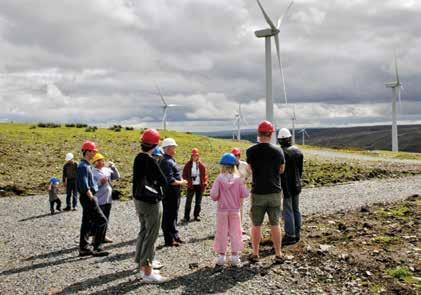
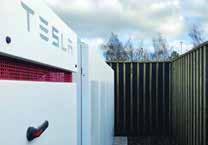
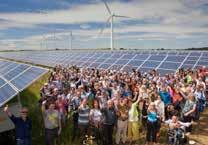
The future role of local energy ownership in the UK

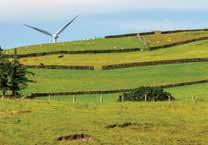
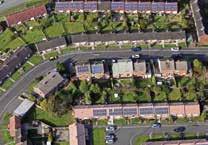
Community energy 2.0
The future role of local energy ownership in the UK
Author Chaitanya Kumar
Acknowledgements
With thanks to Emma Atikins for early research; also thanks to Emma Bridge, Regen, Jonathan Atkinson, Pete Capener, Patrick Allcorn, Shea Buckland-Jones, 10:10 and Carbon Coop.
We are grateful to Friends Provident Foundation for supporting this work.

Green Alliance
Green Alliance is a charity and independent think tank, focused on ambitious leadership for the environment. With a track record of 40 years, Green Alliance has worked with the most influential leaders from the NGO and business communities. Green Alliance’s work generates new thinking and dialogue, and has increased political action and support for environmental solutions in the UK.
Green Alliance
11 Belgrave Road, London, SW1V 1RB 020 7233 7433
ga@green-alliance.org.uk
www.green-alliance.org.uk
blog: greenallianceblog.org.uk
twitter: @GreenAllianceUK
The Green Alliance Trust
Registered charity no. 1045395
Company limited by guarantee (England and Wales) no. 3037633
Registered at the above address
Published by Green Alliance, February 2019
ISBN 978-1-912393-23-7
Designed by Howdy
© Green Alliance, 2019 Green Alliance’s work is licensed under a Creative Commons Attribution-Noncommercial-No derivative works 3.0 unported licence. This does not replace copyright but gives certain rights without having to ask Green Alliance for permission.
Under this licence, our work may be shared freely. This provides the freedom to copy, distribute and transmit this work on to others, provided Green Alliance is credited as the author and text is unaltered. This work must not be resold or used for commercial purposes. These conditions can be waived under certain circumstances with the written permission of Green Alliance. For more information about this licence go to http:// creativecommons.org/licenses/ by-nc-nd/3.0/
Please note: our Creative Commons licence does not cover the use of any photographic images featured in this report which are subject to separate copyright and must not be shared or copied without permission.
Front cover images courtesy of: Westmill Solar Cooperative Project Scene, Trent Basin, Nottingham and Alamy Stock Photo
In 2014, the government’s community energy strategy imagined that one million homes would be powered by community energy schemes by 2020. Four years later, that vision lies abandoned with only 67,000 homes benefiting.
Since the scrapping of the strategy and the subsequent reduction in feed-in tariffs, community energy groups have struggled to make a reasonable business case. Consequently, in 2017, it is known that at least 66 community projects either stalled or failed. The government has now decided to scrap feed-in tariffs entirely by March 2019, which will create a cliff edge for small generators reliant on the income.
However, all is not lost for community scale energy schemes. Dramatic cost reductions in renewable energy, the advent of electric vehicles, cheaper batteries and greater automation is changing the way we generate and consume energy, leading to a more distributed, decentralised and digitised system. Within this context, community energy has a new opportunity to evolve, innovate and play a critical role in this future, and indeed some groups already are.
To adapt to this context, community energy groups will need to change their offer. They need to provide more value to the energy system by offering flexibility and demand reduction services. This will cut the cost of the whole energy system. In return, the government needs to expand its definition of cost to one of value: providing energy is not just about cheap kilowatts. Community energy creates social value and is popular. People may be willing to pay a bit more for more agency and control, and to keep more value in their communities. In any case, new technology means that a future community-led energy system could be the same cost or cheaper than a traditional centralised one.
1
Executive
summary
Climate minister Claire Perry has claimed that the future of energy is local. We believe that is true. However, ensuring the most benefit is derived from local energy means allowing community groups a growing share of ownership.
The government is consulting on the design of the future energy system which will include new rules and regulations to determine how we buy, sell and manage our energy. In this new future, community energy groups can no longer be seen as fringe and their voices have to be considered. This should include accounting for the full value of their contribution to the local economy as well as to the wider energy system.
The development of distributed energy technologies and different ownership models throws up new challenges for policy makers. We make the following recommendations to the government to support the community ownership of energy in a way that also meets its goal to rapidly decarbonise the economy:
1. Open new routes to market for community energy schemes
Community groups should not expect government handouts but they do need support to develop new business models. Community projects with small scale energy demand and generation assets should be allowed to participate in emerging local energy markets, including those for flexibility and capacity. In addition, community groups should have access to a ring fenced pot of contracts for difference (CfDs), just as large scale generators have.
2
2. Design local energy markets that fully value community energy
Community energy projects should be valued for all the services they can bring to the grid and the wider economy. This includes carbon reduction, building local economic and energy resilience and a host of other social benefits that come from reinvesting profits locally. To recognise this value, Ofgem should regulate system operators to include community projects in their flexibility and capacity procurement strategies.
3. Stimulate local innovation with more trials
Community energy groups should be invited and supported to participate in local trials for flexibility, demand management, peer to peer trading and other specific services to the grid, like network costs avoidance. The few trials currently underway are dominated by incumbent actors. The government should ensure invitations to trial are well publicised and accessible while lowering the minimum levels of investment, for community groups to engage.
4. Support clean energy ownership through community enterprise
A variety of approaches to community ownership, including joint ventures, split ownership and shared revenue, were described in the 2015 Shared Ownership Taskforce report and these should be considered and implemented where appropriate. Community benefits from energy projects should be given material weight in planning applications. And local authorities should work with community energy groups, through Local Enterprise Partnerships, to deliver targeted energy services that support vulnerable households and contribute to the local economy.
3
Community energy has grown steadily in the UK over the past two decades. There are now around 300 projects, providing renewable energy to their communities and use the profits generated to support local social programmes. A strong desire for local control over energy sources, and to address climate change, are the primary motivations for this development.
A policy framework to provide greater support for community energy, outlined by the former Department for Energy and Climate Change, was shelved in 2015. There has since been a gradual reduction of feed-in tariffs, the payments for renewable energy generated by homes and community projects, with a decision to end them completely by March 2019. Embedded benefits for distributed generators, ie payments received for reducing dependence on the transmission network, have also been cut. There are indications that other policies which support local renewable energy uptake will be wound down by 2020.
This context is a challenge as well as an opportunity for community energy groups. As generation and export tariffs come to an end, projects will become unfeasible on current economic grounds.1 However, even with the challenges of raising project finance, groups are innovating around new business models that do not rely on government support. Models being trialled in the UK and around the world will establish the new norm for the energy markets of the future, one where there is economic value in providing energy sources and flexibility at a distributed and decentralised level.
In this report we highlight these opportunities and how regulation should be supporting community energy development to maximise the benefits it can offer to the UK’s evolving energy system.
The number of new community energy projects in England, Wales and Northern Ireland has fallen dramatically since 20152
4
2017 2016 2015 2014 2013 2012 2011 2010 2009 2008 6 17 17 23 22 22 33 33 13 1 Introduction
What is community energy?
The definition of community energy is debated but we have based our definition on that used by UKERC:3
We define it as:
Any energy project that is wholly or partly owned or controlled by a community group, including energy co-operatives;4 or
Any energy project where two or more of the following conditions apply: a community group that hosts a project on a site they own or manage; community benefit societies, including non-localised schemes, where profits are directed towards the community and members share democratic control; there is an active role for community members in the project, perhaps taking part in collective energy saving actions, active load management or producing energy (eg through domestic solar PV) shared among other community members through some kind of local supply arrangement.
This definition covers energy service companies which are emerging in response to changes in the energy market, access to finance and consumer needs.
5
How the UK’s energy landscape is changing
Community energy is operating in a significantly different technology context today than it was in 2010. Climate policy, in the UK and globally, has initiated a rapid technological shift towards cleaner energy.5 Five trends in particular are relevant to the role of community energy over the coming decade.
1. Renewable energy is now the cheapest source of energy
Wind and solar are now cheaper than fossil based energy (on a levelised cost basis) in several parts of the world.6 In the UK, onshore wind projects offer the cheapest form of electricity generation. The falling cost of renewable energy and greater awareness of climate change will contribute to the rapid adoption of distributed energy technologies across public institutions, corporations and, increasingly, among households. According to a recent study, 11 million households could be producing or storing their own energy in the UK by 2030, compared to just over a million today.7 The government expects falling costs to result in greater investments with nearly 30GW of renewables and storage to be built by 2030.8
6
Solar panel systems Wind turbines 2008 2010 2012 2014 2016 2018 $4 million per megawatt 2 0
Costs for wind and solar power equipment are falling9
2. Battery storage costs are falling
Batteries will play an increasingly important role in balancing an energy system dominated by variable renewables as well as in powering transport. The cost of battery storage has been prohibitive but, since 2010 it has fallen considerably from around £1,000 per kWh for lithium ion batteries in 2010 to £140 per kWh today.10 Tesla batteries, for example, are estimated to reach the tipping point of £80 per kWh by 2020 with the wider sector not too far behind.11 This will make electric vehicles cheaper and reduce the costs of balancing the electricity grid.
since 2010...12
...and this is accelerating electric vehicle uptake13
7
1000 800 642 599 540 350 273 209 176 2010 2011 2012 2013 2014 2015 2016 2018 2017 20% Battery pack price ($/kWh) 20% 7% 35% 16% 10% 22% 24%
Battery costs have fallen by over 80 per cent
Total cars Electric vehicles Petrol and diesel
2015 2020 2025 2030 2035 2040 2045 2050 Vehicles (millions) 10 20 30 40
vehicles
“According to a recent study, 11 million households could be producing or storing their own energy in the UK by 2030, compared to just over a million today.”
3. More technology is now closer to the ‘grid edge’
Cheaper renewables have meant a greater number of energy assets are being connected at the distribution level, or the so called ‘grid edge’ (ie closer to the source of energy demand). Today, 30 per cent of the UK’s energy capacity is decentralised and connected at the distribution level and much of this has been installed over the past five years.14 National Grid, in a recent future scenario, estimated that 65 per cent of all energy capacity could be distributed by 2050.15 This means millions of households would have solar panels and batteries, which is a near five fold increase in onshore wind capacity and other local distributed technology. Consumers are rapidly adopting appliances like smart meters, thermostats, inverters and other ‘internet of things’ technologies that interact with the power system. By 2040, the International Energy Agency estimates that, globally, a billion households and 11 billion smart appliances could actively participate in local, interconnected electricity systems.
Growth of distributed generation in the UK16
8
2012 Generation volume (GWh) 2013 2014 2015 2016 2017 2018 2019 Wind Fossil Photovoltaic 0 200 400 600 800 1,000 1,200 1,400 1,600 1,800 2,000 2,200
“65 per cent of all capacity could be distributed by 2050.”
4. Household electricity bills could rise
A rise in wholesale prices, network and policy costs could mean a 30 per cent increase in a household’s electricity bill by 2025.17 Recent reports indicate that over 2.93 million households are currently in energy debt.18,19 This is reflected in a recent public attitudes survey for the Department of Business, Energy and Industrial Strategy, which suggests that almost one in three energy consumers are worried about paying their energy bills.20
9
Average household electricity bills could rise without efficiency 214 283 619 807 136 206 170 201 99 117 Wholesale £ per annum 2017 2025 Policy Network Other +30%
£200 2003 2006 2009 2012 2015 2018 £250 £300 £350
The
fuel poverty gap has grown since the early 2000s
5. Consumer demand is changing
Consumer support for renewable energy has reached an all time high, at 85 per cent, with 80 per cent agreeing that renewable energy should provide direct benefit to their local communities.21 At the same time, consumer trust in the Big Six energy suppliers is at an all time low, with more now choosing alternative, smaller suppliers.22 This trend is also causing a shift, by some, towards using more decentralised technologies, offering the promise of greater democratic control of energy, led by consumers.23
Community energy has been an important part of this shift and, since 2008, the sector has grown considerably.24 The motivations are varied, ranging from addressing climate change to tackling local fuel poverty and providing more affordable energy. As energy technologies get smaller and can be more consumer driven, these motivations are increasing.
10
“Consumer trust in the Big Six energy suppliers is at an all time low, with more now choosing alternative, smaller suppliers.”
Nuclear Increasingly state led Consumer led Heat pumps Onshore wind Solar Electric vehicles Batteries Tidal lagoons Interconnectors Demand side response Offshore wind Carbon capture and storage Combined cycle gas turbines
The future for community energy
Renewable energy subsidies are being removed as the intended outcome of cost reductions has been achieved, although the timing and distributional effects of subsidy cuts still needs consideration, as we discuss later.
Even without subsidies, individuals and communities will increasingly find cheaper renewables more cost effective and attractive than relying on centralised infrastructure. Distributed energy technologies have the potential to transform homes into active energy market participants, buying and selling power to their neighbours or the local grid. By channelling profit back into the community and deploying energy efficiency measures, a virtuous cycle of cheaper bills and decarbonisation could be created.
These outcomes are by no means guaranteed but attempting to achieve them presents a set of opportunities and challenges for energy system designers. Balancing costs while reducing carbon are clear policy imperatives but we make the case for allowing community energy to participate fully in the future energy system to achieve wider environmental and social objectives.
A vision for 2030
The year is 2030. The UK’s electricity grid is dominated by efficient, clean and low cost renewable energy, providing electricity and heating to millions of homes and business.
Large companies now compete alongside community owned decentralised service providers to operate consumer and distribution level resources.
Millions of households and businesses produce their own energy with onsite and rooftop solar, wind and other renewable generation.
Community energy is a significant part of the energy system, generating and storing energy locally. It is providing customers with cheap, clean, reliable and sustainable energy. Community scale business models include platforms for individual households to transact electricity with their peers across their local grid.
These platforms started as a way for customers to participate more actively in controlling their energy, but has evolved into a way to deliver other services such as energy efficiency, energy analytics and active demand management.
Being modular and local, community energy contributes to ensuring that critical services remain up and running during grid disruptions, natural disasters and extreme weather events.
11
Most businesses and homes across Britain own or manage some form of distributed generation like energy storage, electric vehicles, smart meters or demand controllers, and are actively participating in new markets and services to help to balance a highly electrified and flexible energy system. Distributed generation assets are shared between community energy operators and grid operators.
Community energy projects support their local economies by providing construction, management and other jobs across the supply chain, while also improving the situation for local, fuel poor households by redirecting profits to help them.25 They also play an important role in helping their members provide services from their energy resources and invest the profits in positive social outcomes locally.
Year 2030: power sector dominated by renewables
12
Community energy scheme Social benefits Environmental benefits Local jobs
Energy and information flows
Community owned renewables
Supply and demand shifting services
Services to energy demand aggregators and utilities
Services to suppliers and energy utilities
Power Purchase Agreements with public and corporate purchasers
Distributed energy resources
Millions of homes and businesses have some form of generation, battery storage, EVs and smart thermostats
Direct supply and bespoke tariff structure
Energy efficiency programmes and active demand control
Energy analytics
Trusted intermediaries
System operators
Buying energy and flexibility services for real time system balancing
Contributing to local grid resilience
13
Technology driving community energy
Expanding the role of community energy will involve the uptake of more distributed energy resources (DERs). These are established and emerging technologies, services and consumer goods, such as smart inverters, battery storage, energy efficiency measures, demand side response, distributed small scale generation, smart meters and electric vehicles.
Outside the UK, growth in DERs has been seen as a possible hindrance to large scale renewable deployment by big operators. But, in an energy system that requires ever greater amounts of flexibility, they can play an important complementary role in a low carbon power system, making it more efficient and ultimately reducing costs to the end consumer.26
Incumbent energy companies are beginning to acknowledge this and are making heavy investments into DERs like batteries, electric vehicles and demand response, with an aim to cash in on the growing low carbon energy market. These investments are not just in clean energy generation but in digital systems and smart infrastructure, as we show below.
The roll-out of digital electricity infrastructure to all homes would be a key factor allowing the expansion of community energy but it is not yet widespread, with one survey suggesting 72 per cent of UK consumers are unlikely to adopt smart energy products in the next two to five years.27 This can be attributed to a lack of information about what is available, mistrust in service providers and concerns about price. But, much like the adoption of smartphones, the survey suggests, in the near future uptake is likely to grow at an accelerating pace rather than subside. The use of one energy product has also been shown to have a significant influence on procuring more, as seen for instance with the correlation between electric vehicle buyers adopting solar panels and vice versa.
14
2014 0 20 40 2015 2016 EV chargers Smart grid infrastructure Smart meters $ billion
Global
investment
in
digital electricity
infrastructure and
software
is going up28
Electricity systems software Industrial energy management software Building energy controls
Market transition
Community groups will need to improve their understanding of the distinct capabilities and value of DERs, particularly as more individuals and local groups are likely to be able to afford to buy and manage these resources. A distinct advantage of community enterprises is their role as trusted intermediaries between the consumer and the energy system. As we explore further in this report, this function will only increase in value within a distributed and decentralised energy system.
The early phase of the market for community energy was heavily dependent on feed-in tariffs and other benefits driven by government subsidies. But the energy market is currently in transition, with new business models being developed for a post subsidy era. Important regulatory decisions are also being taken, on local energy markets, network charging, energy market governance, and the transmission and distribution network interface, that will affect the operating environment for community energy businesses.
As a result of these changes, a more mature market will emerge in the early 2020s. This could open up new markets at the local, distribution network level, where community groups will be able to actively participate in and deliver services to the local grid, accruing associated revenue. However, there are significant barriers to realising this market and important regulatory changes are necessary.
The rapid uptake of DERs at the individual and community level in future is a challenge that policy makers will have to address. Unlike a scenario where regulators are constantly playing catch up, as we have seen with the growth of solar energy in the UK, regulation should ensure early on that consumers, communities and small stakeholders are given fair access to the energy market.
A centralised energy system operates primarily through the wholesale market, and its economic value lies mostly in reliable electricity generation. A more distributed and flexible energy system will need different sources of value and revenue. For DERs, this lies in providing not just electricity but other energy services that help to keep the power grid stable and allow supply and demand to be met in real time. We outline below different types of DER and show the variety of services they can provide.
The government has made its intentions clear: it wants to adopt a more efficient, market led approach to the energy transition in the light of the falling costs of renewable energy. But, from a regulatory point of view, community groups share a legitimate concern that large incumbent energy companies wield undue influence over the direction and shape of this transition, potentially shutting out less powerful operators.29 As we pointed
15
“A distinct advantage of community enterprises is their role as trusted intermediaries between the consumer and the energy system.”
out in our 2017 report People Power, public policy that suppresses growing consumer demand for distributed clean energy could have negative consequences.30 A decentralised, consumer centred approach to energy system design, which includes consulting local energy groups, would avoid this.
The changing community energy market
Early market (2010–18)
Community energy growth based on feed-in tariffs and similar policies.
Most business models are reliant on the generation and export of renewable energy and targeted energy efficiency programmes. There is growing awareness of community energy projects and their benefits.
Case studies are established
Market transition (2018–23)
Technology costs continue to drop and new business models are developed to reach a wider consumer base, based on optimising the use of DERs at the domestic and local level.
Policy makers and industry representatives, consult on and establish stable, long term value for distributed generation, which ultimately reflects the full breadth of community energy’s benefits, including its positive social impact.
Mature markets (2023–)
Community energy projects engage consumers in a variety of ways, providing a host of energy services.
Uptake is dramatically increased
Projects participate in new markets to provide holistic services to the energy grid, including demand response, grid frequency stabilisation, balancing local supply and demand, and other as yet untested functions.
16
Types of distributed energy resources
Distributed generation This is also known as embedded generation and refers to small scale power technologies like solar PV, small scale wind, combined heat and power, anaerobic digesters and fuel cells. Systems are decentralised and connected to the distribution grid. The UK currently has over 30GW of distributed generation capacity, representing 29 per cent of the total grid capacity.
Battery storage Located in homes or directly connected to the distribution network, this provides services like voltage regulation and frequency response to the network. Batteries can potentially act as dispatchable resources, ie they can generate power when needed, when paired with variable sources like wind and solar. The UK already has 3GW of installed battery capacity, equivalent to powering 300,000 electric vehicles, with an additional 7GW in the pipeline.
Energy efficiency The use of energy efficient lighting, insulation, efficient heating, monitoring and control measures are some of the approaches that can reduce absolute energy demand. This has even greater value in areas where the grid is under pressure from high energy demand.
Demand response This involves shifting energy demand, up or down, in response to market incentives or system requirements like dealing with scarcity of supply, changes in generating capacity, peak load, ramping requirements, transmission or distribution constraints, or voltage irregularities. In the UK, demand response contributes 1.4GW to balancing and 2.1GW for capacity market mechanisms.
Electric vehicles Smart charging allows access to the capacity of electric vehicle batteries which can provide a variety of services to the grid. The UK currently has 160,000 electric vehicles and is expected to reach a million by 2022. National Grid estimates there will be up to 1GW of vehicle to grid capacity by 2030.
Smart inverters These convert direct current from generators to the alternating current supplied to the grid. Smart inverters can manage the output of a distributed generation system and can help to resolve grid constraints by providing voltage support, frequency regulation and ramp rate control.
For more information about DERs and the services they can provide to the energy system, see the annex on page 38.
17
Valuing distributed energy resources
To make the most of the services that the DERs managed by community groups can offer the grid, new markets in flexibility at the local network level are needed, particularly as smaller players increasingly seek active participation in the energy system.
National Grid currently operates flexibility markets nationally and it is working towards introducing new products that can allow small energy assets to participate. But energy assets in individual homes or communities and those connected to low voltage lines might be better suited to new local energy markets. In its role as an Independent System Operator, National Grid is also currently responsible for the real time balancing of energy supply and demand but, as more DERs populate the grid edge, it will be necessary to decide how best to utilise them.
Once distribution system operators are established as independent bodies, they will be expected to play an increasingly important role in bringing real time supply and demand balancing to the distribution level. Balancing an energy system running on highly variable renewables will require an increasing amount of flexibility, a service estimated to be worth £8 billion by 2030, according to the National Infrastructure Commission.31 System operators will have to buy flexibility, while reducing the cost of balancing supply and demand. DERs can provide this service and earn revenue by doing so.
Local energy flexibility markets are currently at the trial stage to determine the possibilities for value or price discovery. Market rules are yet to be established. It is important that the full value community energy can bring to the energy system is taken into account as these rules are decided. Opposite is an example of what a whole system view of the value of DERs would look like.
18
DERs and the energy system: costs and benefits
DER value
Description
Costs
Administrative costs
Integration costs
Avoided energy
Avoided curtailment
Additional costs in managing permits and interconnections
Additional cost to grid operator for balancing intermittency
Eliminating the need for the equivalent amount of fossil fuel energy generation
Avoiding curtailment or waste of excess renewable electricity by turning up demand
Energy system benefits
Avoided capacity
Avoided transmission and distribution capacity and line losses
Ancillary services
Eliminating the need to pay for new generating capacity
Avoiding grid reinforcement costs owing to the location of DERs
Reducing the need for grid support or ancillary services, either from reduced demand or DER services (eg reactive power, reliability).
Price reduction
Carbon reduction
Demand reduction price effects on generation and capacity
Credit for reducing emissions calculated on the basis of the current market price of carbon
Additional benefits
Additional environmental, climate and societal benefits
Benefits to local economy and job creation, grid resilience, public health
19
“It is important that the full value community energy can bring to the energy system is taken into account.”
Value added by community projects
The three turbine, 9MW Bein Ghrideag community owned windfarm in Scotland has been running successfully since 2015. The project contributed £1 million in profits last year to support local projects in the Point and Sandwick area.
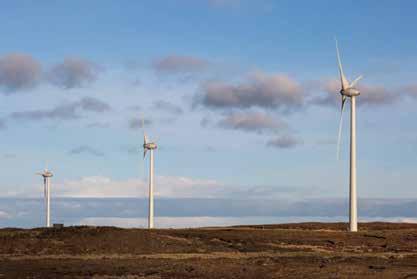
Similarly, 83 community organisations in England raised a collective total of £1.1 million in community benefit funding in 2017 that was fed back into local economies.
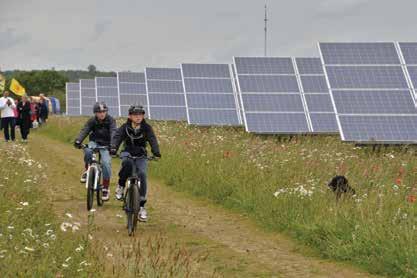
20
The benefits of community energy
For community energy groups to participate in the energy system and build innovative business models, a clear route to market has to be offered. This would be facilitated by better valuing the services they offer beyond energy generation, such as:
Reinvesting the dividends of the community energy project in the local economy.
Alleviating fuel poverty through targeted energy efficiency programmes (in 2017, 76 community organisations were engaged in energy efficiency and demand management programmes).
Avoided CO2 (71,000 tonnes of CO2e has been saved by existing community energy projects).32
Supporting local councils and energy suppliers in tackling location and context specific challenges, like smart meter roll-out and energy efficiency programmes.
Greater public engagement in the energy system, helping them adjust to a low carbon and smarter system.
Contributing to grid resilience through the establishment of microgrids and other services that can weather the impact of natural disasters like floods.
To maximise these benefits, purchasers of energy services should be encouraged to buy them, wherever feasible, from local community energy projects instead of other sources. This is unlikely to happen until there is a clear value for the additional services.
Several distribution network operators (DNOs) have adopted a ‘flexibility first’ approach to their businesses. They will test the market to see what flexibility services are available from projects using smart technologies such as renewable energy generation, demand side response and energy efficiency measures, and compare the cost of using them against building new energy infrastructure.33
The work of SSE Networks on Social Constraint Management Zones is an example of a DNO trialling new ways to buy flexibility through an open market platform. It aims to encourage participation by community energy groups and other local energy providers. The DNO organises ‘matchmaking workshops’ where constraints on the network and solutions from local flexibility providers are ‘introduced’ to each other. Community energy groups are linked up with consultants and academics for support in navigating the transaction.
21
“For community energy groups to participate in the energy system a clear route to market has to be offered.”
The need for a social metric
Other ways are also being explored to value the unique benefits of community energy projects. This includes credits for carbon saved and for local economic and social benefits, eg supporting vulnerable customers, creating local jobs, supporting local authorities in delivering their energy programmes and accelerating the domestic uptake of DERs.
Ofgem, through the RIIO (Revenue = Incentives + Innovation + Output) mechanism, already offers incentives to DNOs tied to achieving specific objectives. A new feature of this is to expect DNOs to engage community energy groups, as part of the ‘minimum requirement’ of a stakeholder engagement incentive scheme.34 This also requires DNOs to demonstrate how stakeholders’ views were considered and acted upon. To improve this scheme, DNOs should be given incentives, through a thoroughly consulted and clearly defined metric, to value the wider social benefits of community energy.
A suitable methodology is needed to fully value community energy so there is a fair market environment which encourages the participation of local groups and individuals.
22
“Distribution network operators should be given incentives to value the wider social benefits of community energy.”
Models of innovation
The following three examples demonstrate how community energy groups can contribute to the energy system and deliver long term benefits for their communities.
Community supply and aggregation
Community Choice Aggregators (CCAs) are independent energy suppliers that buy energy on behalf of small users, households and small businesses in California. They develop their models based on a community’s preferences for energy supply and use revenues for funding local programmes like energy efficiency or for offering further tariff rebates. CCAs now cater for 16 per cent of California’s retail energy demand, and this is expected to rise to 85 per cent by 2025.35 As a result, California expects to meet its 2030 target of 50 per cent electricity supply from renewables early, by 2020.
CCAs, like the UK startup Ripple Energy, are planning to use their public or co-operative legal status to focus on better matching of local demand with supply, while potentially offering lower tariffs (CCAs offer consistently lower tariffs than their investor owned utility counterparts). Energy efficiency programmes targeted at vulnerable or hard to reach households and the use of battery storage, demand side response and peak pricing are other services provided by CCAs. Sonoma Clean Power, a Californian CCA, offers its customers a small incentive of $5 a month to access consumers’ smart devices (like electric vehicle batteries and smart thermostats) to assist in matching local demand and supply.36
In the UK, Ovo Energy and Moixa are trialling similar schemes.37 Moixa’s project ERIC helped to reduce grid constraints in a generation heavy region by aggregating battery capacity to reduce solar exports to the grid.38 The project claims to have cut £170 from the average annual bills of consumers through a ‘solar plus battery’ system at home. Demand response is estimated to bring system savings of £110 million to £530 million a year by 2020 in the UK.39 A significant part of this saving is expected from non-domestic sources but, as more DERs enter the grid edge, domestic demand aggregation and response will be more widely adopted.
Energy Service Companies like Carbon Coop and digital platforms like Upside Energy are developing similar models for residential demand aggregation (otherwise known as a virtual power plant).40,41 Carbon Coop is leading innovation in the community energy sector and calling for an open source approach to demand side response. This ensures customers do not face issues of technology or supplier lock-in and enjoy greater choice depending on their specific requirements. Accumulating residential energy demand and managing it to shift peak load is of high value to the energy system, with one estimate valuing balancing that load through demand side response at £110 million by 2030 (at current balancing prices).42
Trust is often cited by end users as a requirement for them to consider using demand side response systems, in particular in relation to the
23
installation of automatic, remotely controlled devices that modulate energy demand. Community energy groups, by virtue of their strong local relationships, have very high levels of consumer trust and could, therefore, incur lower costs in attracting customers for this service. One research from 2014 showed that people are three times more likely to trust a community energy company to give them a fair deal than one of the existing big suppliers.43 Leveraging this trust could provide them with cheaper access to the DERs owned by their customers.
There are a variety of supplier options that UK community energy groups could adopt, but lack of scale can undermine any business model.44 However, opportunities exist for creative partnerships between community groups and innovative suppliers to deliver cheap, renewable energy to consumers, taking full advantage of the trust community groups have with their local customers.
Battery storage
As feed-in tariffs come to an end, communities and individuals might find it more economically attractive to consume electricity directly from distributed generation like solar rather than export it to the grid. This will require the ability to store electricity during surplus generation and discharge it during times of low renewable generation or peak demand. Community scale batteries also provide a range of benefits that go beyond storage, including avoiding grid upgrades, lowering grid costs, offering the flexibility to support more renewables and providing system resilience and reliability.
The value of such services is dependent on a variety of factors including wholesale electricity prices, network charges, size of ancillary service markets and the scale of batteries used. Research from the Norwegian firm DNV GL found that a community battery could yield a profit of up to £15
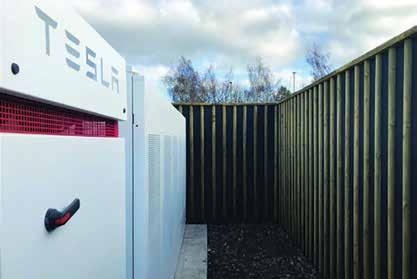
24
“Opportunities exist for creative partnerships between community groups and innovative suppliers.”
million over the lifetime (15 years) of a 10-25MWh battery project by providing services such as frequency response, uninterruptible power supply and managing grid congestion.45 Test cases from the UK show the large revenue opportunity for batteries to offer frequency regulation, reaching up to £330,000 per MW per year.46
For community energy groups with large scale solar assets, batteries offer a proposition to accrue further revenue from grid services, and for those community groups providing and managing rooftop solar, a small scale battery can considerably reduce energy bills.
Spinning reserves Bill management
25
California (CAISO) Eastern US (PJM) UK Australia Canada
Energy storage revenue streams across the world (2017)47
$/MW per year 0 100,000 200,000 300,000 400,000 Regulation
Energy trading
Capacity
Microgrids
There is increasing interest in peer to peer (P2P) trading where consumers actively generate their own electricity (known as prosumers) from domestic sources and trade it locally with their neighbours, while retaining value generated within the community. Trials are underway around the world and the Brooklyn Micro-Grid (BMG) is a useful example. The BMG operates on blockchain technology that facilitates data transfer and energy trading alongside a physical grid of wires that connect the homes participating in the trade. The microgrid remains connected to the larger grid to ensure reliability but can decouple during times of system stress.
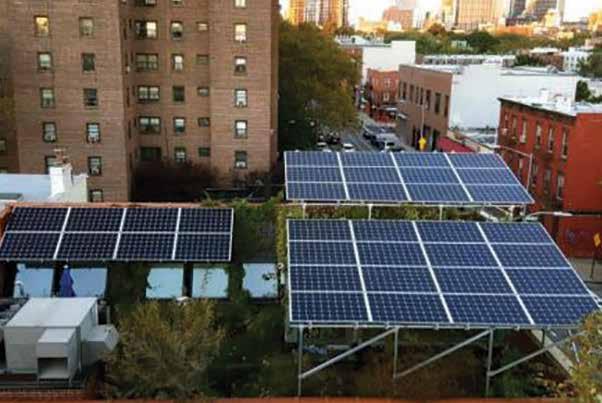
In the BMG, the local trading of electricity is implemented virtually through the TransActive grid blockchain protocol. This could also apply to trading locally in the future.48 Trades occur within short time windows with consumers and prosumers bidding into the market with their maximum and minimum buying and selling prices. In effect, this model is a miniature version of the wider energy market. The P2P market in Germany, enabled by the high uptake of rooftop solar, is estimated at £4 billion a year.49
Microgrids are platforms where consumers pay local prosumers to generate their energy. This stimulates the adoption of decentralised renewables and contributes to faster decarbonisation. Community scale microgrids benefit the local economy as trading profits stay in the community instead of transferring to large utilities.
Microgrids can also provide ancillary services to the national grid, as shown opposite, like demand management, continuity of service at times of disaster and other forms of flexibility.50
26
“The peer to peer market in Germany, enabled by the high uptake of rooftop solar, is estimated at £4 billion a year.”
How peer to peer energy trading could work in a community51
27
Prosumer Peer to peer p2p app Trading platform Smart meter Signals of availability Consumer p2p app Kwh £ Energy token £ Energy token Energy token
Innovations in the UK energy sector
In the future, the UK’s homes will be able to function as integrated units, actively participating in the energy system and responding to real time price signals. The following are just some examples of developments on the horizon that would enable this:
1. Demand side aggregation Start-up Social Energy is partnering with Duracell to install and aggregate the 350MW cumulative capacity of 3kW and 6kW home battery storage units by 2020 in the UK. The company has secured a contract with National Grid to provide firm frequency as a service. It claims its software can better monitor demand and export and import electricity at best prices.
2. Peer to peer trading Energise Barnsley has won the Ofgem Sandbox competition to establish whether it is possible to develop a tariff or trading system to allow households without solar PV to purchase exported solar energy generated by their neighbours. The Northern Powergrid could act as a balance and checking mechanism for a P2P retail energy platform like this.
3. Vehicle to grid charging OVO energy has produced a 6KW vehicle to grid (V2G) charger. As part of a trial, it is offering drivers of Nissan electric vehicles the opportunity to discharge excess electricity from their cars back to the electric grid to help supply energy at times of peak demand. Large utilities like EDF and E.On are investing significantly in creating virtual power plants made up of several thousand electric vehicle batteries.
4. Time of use tariffs Octopus energy has launched an Agile Octopus tariff, a time of use tariff that rewards demand flexibility in response to external price signals. The company claims the average customer on the tariff would save £188 per year by shifting their consumption away from peak times.
5. Flexibility platforms Piclo, a flexibility trading company, has developed a popular trading platform for buyers and sellers of flexibility services. All six distribution network operators have joined this platform to trial innovative ways to locate and trade DER flexibility.
6. Energy Service Companies (ESCOs) Companies like Smartklub are offering to optimise community level distributed energy systems including electric vehicles, batteries and rooftop solar. ESCOs work with local utilities but replace them as the locus for customer relations.
28
Examples of value creation opportunities for community energy groups52
Energy
efficiency Demand response
Equipment upgrades
Targeting fuel poor households
Maintenance and monitoring
Energy demand control
Price/demand alerts
Ancillary service programmes, eg flexibility
Community energy schemes
Distributed generation Information services
Solar Battery storage
Backup generation, eg small hydro
Demand and usage analysis
Measurement and verification
Local supplier
Bespoke tariffs to meet local demand with local generation
Public and corporate Power Purchase Agreements
29
Keeping value in the community
Community energy groups are created to benefit the local community with cheaper low carbon energy or to support local community development activities. As shown above, the growth in DERs could bring significant value to the energy system. However, not all that value necessarily accrues to the individual consumers who own the energy resources. Depending on the scale of intermediaries, it can end up distributed across the supply chain, beyond the locality.
Helping community energy groups to keep the value in the local community should be a key policy objective for the government. Three ways to do this are:
1. Local supply options
This would allow community owned and sited generation assets to provide electricity directly to the households and small businesses within the community at bespoke local tariffs. It would provide market certainty for generators and retain all the value generated locally. Such an opportunity fosters a greater sense of ownership in community projects.
Under current supply options, community groups are not licensed to perform the function of a supplier. But projects like Repowering London in England, Energy Local in Wales and Smart Fintry in Scotland are trialling local supply models, deploying peer to peer trading while partnering with a default supplier to ensure real time matching of generation with demand.53,54,55
In a recent response to its call for evidence on the future supply market arrangements, Ofgem announced that it considers the Supplier Hub model, which currently allows only a single entity (the supplier) to be the intermediary between the consumer and the energy system, to be unfit for purpose.56
Opening up consumer access to multiple suppliers will facilitate greater competition and allow community energy projects to generate and retain economic value within the community.
30
2. Community enterprise and ownership
Tough planning conditions and the lack of a stable route to market have meant there is now no pipeline for onshore renewables development in England.58 However, in Scotland, a 2016 national policy statement on onshore wind has actively encouraged the development of community ownership models.59 This includes negotiating an agreement on a community equity share of the project, alongside a fixed contribution from the developer to the community depending on the scale of the project (often an amount per MW). As of June 2017, there were 40 unique shared ownership projects where local communities owned between a ten and 30 per cent stake.60 One such project, the Neilston Community Wind Farm, chose to sell its 28 per cent share when the developer sold the site. This earned approximately £2 million in profit which the community was able to invest back into creating jobs and improving local infrastructure.61
A variety of approaches to community ownership, including joint ventures, split ownership and shared revenue, as described in the UK government’s 2015 Shared Ownership Taskforce report, could be implemented.62 Enabling clean energy ownership through community enterprise meets the twin objective of decarbonising with cheap onshore renewables and winning the support of the local community.
31
“Scotland has actively encouraged the development of community ownership models.”
An example of how community energy could fit into future home energy supply57
Community energy scheme (via supplier A): offers power at bespoke tariffs to local customers
EV company (via supplier C): bundles an electricity tariff with the vehicle
Default supplier (via supplier B): balances demand in real time
Household electricity demand
3. Partnerships with councils and other local bodies
Partnerships with energy suppliers, commercial renewables companies, housing associations, local businesses and private housing suppliers are important in locating and sustaining the benefits of community energy in a specific area. Local authorities are best placed to facilitate collaborations between these bodies and local community energy groups. Collaboration of this sort brings mutual benefits where the involvement of a community group builds local engagement while the project benefits from the expertise, finance and reputation of established organisations.63
Local authorities are increasingly exploring opportunities to enter the electricity supply market. Nottingham City Council and the Liverpool city mayor, for instance, both own and operate not-for-profit supply companies that aim to reduce energy bills and support fuel poor households. In such contexts, community energy groups can work with local authority suppliers to provide cheap, low carbon energy, while helping to balance supply and demand.
Local Enterprise Partnerships, established to support local businesses and stimulate the growth of local economies, are established agencies that can constructively support community energy.They can encourage private business to provide financial support to local energy groups, support local research and innovation and work with public sector partners to deliver targeted energy services; this will have the benefit of helping vulnerable households and contributing to the local economy. Partnerships with local businesses, for example, could be encouraged by motivating owners of business premises to work with communities on rooftop solar schemes, through reducing business rates. Similarly, partnerships with local housing developers can allow community groups to develop and finance renewables schemes alongside housing projects.
Over 20 local councils in cities across the UK have declared a ‘climate emergency’, with a goal to achieve carbon neutrality in their local area within the next two decades. These are ambitious and timely goals that will require unprecedented public engagement and support.The role for community energy groups is significant not only for developing projects but also gaining public buy-in for a rapid energy transition.64
32
“Community energy groups can work with local authority suppliers to provide cheap, low carbon energy, while helping to balance supply and demand.”
Recovering network costs
Network charges contribute between a quarter and a third of the average household energy bill in the UK. These charges reflect the costs of recovering capital invested in building and maintaining the networks. For an electricity generator, costs arise from connection to the grid and the ongoing use of the system. Ofgem is currently reviewing how these charges are allocated to network users to correct the skewed distribution of costs and benefits. Given the significant scale of capital recovery needed (£5 billion in the current regulatory period of 2015-23), this review is relevant to all network users, including community energy groups.
There are two particular network related challenges for community groups operating DERs:
Difficulty in connecting to the distribution network: roughly 20GW of accepted connection offers for new DERs were waiting to connect as of May 2016. Significant constraints in the distribution network has meant that developers do not find it straightforward to acquire connection contracts. However, every option in National Grid’s future energy scenarios estimates a growth of at least 10GW of distributed capacity by 2030. Networks regulation should, therefore, aim to free up grid constraints and facilitate the greater uptake of DERs.
Cuts to benefits for embedded generation: existing benefits for DERs connected to the distribution network have been reduced by more than 90 per cent, with further reductions expected. These benefits have played a critical role in creating a market for distributed generation, offering rewards for the network services it can provide. In the future, developers will need alternative market signals to stimulate further growth and investment in DERs.
Addressing these challenges requires a new approach to the way network costs are recovered. Ofgem, as the national regulator responsible for the methodology, should carry out a cost benefit analysis of the role active customers and community energy groups could play in the energy system, in particular in relation to avoided CO2 emissions and the cost savings compared to traditional grid reinforcement. Studies from the United States have shown how appropriate valuation of community owned distributed energy can offer better tariffs than average retail rates.65
Simplifying data on grid constraints that need addressing across all network areas and making the information more accessible will help to create a more level playing field for community groups. Network charging should also reflect the value that community energy can bring to local networks.
33
The relevance of the EU’s Clean Energy Package
The EU, under its Clean Energy Package, is negotiating the rules and principles that underpin the future electricity market. The recast directive on the internal market for electricity introduces the notion of a citizens’ energy community.66 The directive defines this as “a legal entity which is based on voluntary and open participation, effectively controlled by shareholders or members who are natural persons, local authorities, including municipalities, or small enterprises and microenterprises”. It defines the primary purpose of such an entity as providing environmental, economic or social community benefits for its members or the local areas where it operates. Its activities can encompass electricity generation, distribution and supply, consumption, aggregation, storage or energy efficiency services, generation of renewable electricity, charging stations for electric vehicles or other energy services.
The directive, irrespective of the Brexit outcome, has important implications for the way the UK designs its energy market. Some of the key features of its proposition for citizens’ energy communities include the following:
1. They are entitled to own, establish, purchase or lease distribution networks and autonomously manage them and can access all electricity markets either directly or through aggregation in a non-discriminatory manner.
2. A relevant distribution system operator should co-operate with citizens’ energy communities to facilitate electricity transfers within the communities.
3. Citizens’ energy communities constitute a new type of entity due to their membership structure, governance requirements and purpose. They should be allowed to operate in the market without distorting competition subject to the same rights and obligations as the other electricity undertakings.
4. Citizens’ energy communities are subject to non-discriminatory and transparent registration and licensing procedures and cost reflective network charges.
If the UK agrees on a transition period with the EU, it is likely that this directive could be transposed into UK law. However, if the UK chooses to diverge on its energy rules post-Brexit, there could be implications over the long run in terms of cross border market linkages.
The directive emphasises a clear role for community groups to actively contribute to the energy transition. In line with this, the UK government should ensure that community energy groups are not left behind and appropriate market rules are established to enhance their participation.
34
What needs to change
In redesigning the energy system, policy makers should take the following steps to improve the recognition and management of community energy’s important and rising contribution:
Design markets that value community energy
Community energy projects should be valued for the energy services they can bring to the grid and the wider energy system. This should include the wider benefits of carbon reduction, local resilience and the other social benefits they offer. As energy technologies become cheaper and are increasingly deployed at the local and household level, there will be greater value in trusted bodies like community energy groups undertaking the important work of engaging consumers, helping to gain their acceptance of new technology. These additional benefits should be a central consideration in ensuring community groups are allowed fair participation in emerging local, flexibility markets.
Open new routes to market for community groups
With the phase out of feed-in tariffs, community energy businesses need new routes to market. Many of them cannot take the same market risks that commercial actors can and require support to make investments. This could include, among other things, a principle of a social impact driver. This will encourage both public and potentially private corporate buyers of energy to strike long term Power Purchase Agreements with community energy businesses. Policy should also remove the restrictions that prevent community businesses operating as local energy suppliers. Onshore wind and solar energy, two of the cheapest forms of energy, do not have a clear route to market and onshore wind also faces an uneven playing field with additional planning hurdles. One route to market is the contracts for difference (CfD) scheme. The government should allow CfD agreements for these two technologies.
Support community energy’s participation in flexibility and capacity markets
Community groups are not seeking government handouts but they need support to develop new business models. The government should simplify access to flexibility and capacity markets at the distribution and transmission network level and offer greater transparency for new entrants so they can identify where the value is in the supply chain. Where the transition from a distribution network operator to a distribution system operator is underway, incentives should be closely aligned with the support and promotion of local community energy, for instance through innovative collaborations around flexibility procurement, data-sharing and customer engagement.
Support clean energy ownership by communities
A variety of approaches to community ownership, including joint ventures, split ownership and shared revenue, were described in the 2015 Shared Ownership Taskforce report. Commercial developers should be required to use one of these mechanisms to allow communities a share of
35
ownership. Community benefits from energy projects should be given material weight in planning applications and community onshore wind projects should have a level playing field with other renewable technologies in the English planning system. The Scottish Government’s ‘Good practice principles for shared ownership of renewable energy developments’ offer useful guidance on community ownership and planning considerations for local energy projects.
Local authorities play a critical role in local energy development. We recommend that LAs should support community energy groups by providing them with suitable space and working with them, through Local Enterprise Partnerships, in delivering targeted energy services, supporting vulnerable households and contributing to the growth of the local economy.
36
Conclusion
The UK’s energy transition, spurred by regulation, is moving fast and disrupting the existing centralised energy system. New economic value in this emerging order will lie in providing clean, flexible, cheap and local energy to households and businesses.
Industry is already responding by increasing investments in a distributed, decentralised and digital technology. A critical aspect of this shift is the more active participation of consumers, driven in large part by the growing presence of energy technologies in homes and work places and the widening of choice that it presents.
In this context, community energy groups have a new opportunity. As trusted intermediaries between consumers and the energy system, they can ensure consumers get maximum value from the transition. By targeting energy programmes, particularly energy efficiency, at the right households, they can protect the poor and the vulnerable from being left behind. By aggregating domestic energy assets and providing ancillary services to grid operators, they can generate new revenue to benefit local communities. And, as active owners and partners of renewable energy generation, they can develop new business models to accelerate the decarbonisation of the UK economy.
To make the most of these opportunities, however, the government needs to help level the playing field for community groups attempting to access new markets. This includes capacity building to simplify the technical, commercial and policy aspects of the transition. New models of community energy ownership and local partnerships should be explored that make it easier to create and retain value locally.
We believe that, in the energy system of the future, community energy will be a mainstream player and the government should be planning now to help it realise its full potential.
37
Annex
Energy services provided by distributed energy resources:
Voltage regulation A measure of change in the voltage magnitude between the sending and receiving end of a component, such as a transmission or distribution line. Voltage regulation is the ability of a system to provide near constant voltage over a wide range of load conditions.
Frequency regulation This is the injection of active power into the electricity system to restore frequency to normal levels following the loss of a source of supply.
Load following A load following power plant, regarded as producing mid-merit or mid-priced electricity, is a power plant that adjusts its power output as demand for electricity fluctuates throughout the day.
Balancing Load balancing, load matching or daily peak demand reserve refers to the use of various techniques by power stations to store excess electrical power during low demand periods for release as demand rises.
Spinning reserve This is generation capacity that is online but unloaded (not providing active energy to the system) and that can respond in under ten minutes to compensate for generation or transmission outages. ‘Frequency-responsive’ spinning reserve responds within ten seconds to maintain system frequency. Spinning reserves are the first type used when shortfalls occur.
Black start This is the procedure used to restore power in the event of a total or partial shutdown of the national electricity transmission system. Specific power stations with black start capability will be called on by the system operator to restart their main generator and provide start up energy supply to other power stations to restore the electricity network.
38
Unsuitable for reliably performing the specified purpose
May be able to perform a service, but is not well suited or can provide partial support
Able to perform a service, but may be limited by factors such as availability or customer behaviour
Well suited to perform a service; may exceed legacy technologies for providing the service
39
energy resource capabilities matrix67 Technologies Distributed solar Distributed solar + advanced inverter functionality Battery storage Interruptible load Direct load control Behavioural load shaping Energy efficiency Energy Energy generator Energy generator Energy storage Load shaping Load shaping Load shaping Reduce load Generating capacity Distribution capacity Voltage recognition Frequency regulation Load following Balancing Spinning reserves No No Yes Yes Yes No No Non-spinning reserves No No Yes Yes Yes No No Blackstart No No Yes No No No No
Distributed
Endnotes
1 10:10, 2016, Community energy: the way forward
2 Community Energy England, 2018, Community energy state of the sector
3 UKERC, 2018, The evolution of community energy in the UK
4 Co-operatives UK, 2015, Member relations in bona fide community energy cooperatives
5 MIT News, 2018, ‘Explaining the plummeting cost of solar power’
6 Lazard, 2018, Lazard’s levelized cost of energy of energy analysis-version 12.0
7 Delft, 2016, The potential of energy citizens in the European Union
8 Department for Business, Energy and Industrial Strategy, 2018, Updated energy and emissions projections 2017
9 Bloomberg New Energy Finance, 2018, New energy outlook 2018
10 Bloomberg, 2018, ‘BNEF brief: lithium battery prices fall 18 percent’
11 Clean Technica, 2018, ‘$100/kWh Tesla battery cells this year, $100/kWh Tesla battery packs in 2020’
12 Bloomberg New Energy Finance, 2018, 2018 lithium ion battery price survey
13 National Grid, 2018, Future energy scenarios 2018
14 Electralink, 2018, op cit
15 National Grid, 2018, Future energy scenarios 2018
16 Electralink, 2018, op cit
17 Aurora, 2018, Household annual electricity bills will increase by nearly £200 by 2025, driven by rising wholesale and policy costs
18 The Guardian, 2018, ‘Number of UK households in energy debt rises by 300,0000’
19 The Guardian, 2018, ‘Rising energy prices expected to worsen UK fuel poverty’
20 Department for Business, Energy and Industrial Strategy, 2018, Energy and climate change public attitude tracker
21 ClientEarth, 2018, ClientEarth’s climate snapshot: a survey of UK attitudes towards climate change and its impacts
22 Which?, 2018, ‘Energy companies rated’, available at: www.which.co.uk/ media/popup/table-popup-energycompanies-jan-2018-471115.html
23 Green Alliance, 2017, People power: how consumer choice is changing the UK energy system
24 Community Energy England, 2018, Community energy state of the sector 2018
25 Community Energy England, 2016, Fuel poverty and what the community energy sector is doing about it
26 Gridworks and Gridlab, 2018, The role of distributed energy resources in today’s grid transition
27 PwC, 2019, What do your customers really want now?, available at: www. pwc.co.uk/industries/power-utilities/ insights/disrupting-utilities/ consumer-survey.html
28 International Energy Agency, 2017, Digitalization and Energy
29 InfluenceMap, 2017, Gridlock in UK power markets
30 Green Alliance, 2017, op cit
31 National Infrastructure Commission, 2016, Smart power
32 Community Energy England, 2018, Community energy state of the sector 2018
33 Energy Networks Association, 2018, ‘Britain’s local electricity network operators launch ENA flexibility commitment’, available at www.energynetworks.org/news/ press-releases/2018/december/ britain%E2%80%99s-local-electricitynetwork-operators-launch-enaflexibility-commitment.html
34 Ofgem, 2018, Consultation on changes to the: stakeholder engagement incentive scheme guidance and stakeholder engagement and consumer vulnerability incentive guidance, available at www.ofgem. gov.uk/system/files/docs/2018/11/ consultation_on_proposed_changes_ to_sei_and_secv_guidance.pdf
35 Next 10 and UCLA Luskin Center for Innovation, 2018, The growth in community choice aggregation: impacts on California’s grid
40
36 Sonoma Clean Power 2019, GridSavvy, available at sonomacleanpower.org/ programs/gridsavvy
37 Ovo Energy, 2019, Vehicle to grid charger, available at www.ovoenergy. com/electric-cars/vehicle-to-gridcharger
38 PV Tech, 2018, ‘Virtual reality: VPPs in a break with tradition’, available at solar-media.s3.amazonaws.com/assets/ Pubs/ESN resources/16_VPPs.pdf
39 Charles River Associates, 2017, An assessment of the economic value of demand-side participation in the balancing mechanism and an evaluation of options to improve access
40 Carbon Co-op, 2019, About us, available at http://carbon.coop/about-us
41 Upside Energy, www.upsideenergy. co.uk/
42 Carbon Co-op, 2018, Energy Communicator Aggregator Services
43 OVO Energy, 2014, Community energy white paper
44 Stephens Scown and ReGen SW, 2016, Local supply: options for selling your energy locally
45 DNV GL, 2018, ‘DNV GL-led consortium finds viable business case for community energy storage’, available at www.dnvgl.com/news/ dnv-gl-led-consortium-finds-viablebusiness-case-for-community-energystorage-115848
46 Ibid
47 Lazard, 2018, Lazards’s levelized cost of storage analysis – version 4.0
48 E Mengelkamp, et al, 2016, ‘Designing microgrid energy markets: a case study: the Brooklyn microgrid’, Journal of Applied Energy
49 Exergy, 2018, Exergy business whitepaper
50 Ibid
51 Exergy, 2018, Exergy business whitepaper
52 Engie, 2018, Engie’s formula forward
53 Energy Local, www.energylocal.co.uk
54 Smart Fintry, www.smartfintry.org.uk
55 Ofgem, 2018, Future supply market arrangements – response to our call for evidence, available at: www.ofgem.gov.uk/system/files/ docs/2018/07/future_supply_market_ arrangements_-_response_to_our_ call_for_evidence_0.pdf
56 Elexon, 2018, ELEXON white paper: enabling customers to buy power from multiple providers
57 Ibid
58 Parliament, 2015, Written Statements, Thursday 18 June 2015, available at publications.parliament.uk/pa/ cm201516/cmhansrd/cm150618/ wmstext/150618m0001.htm
59 Scottish government, 2017, Onshore wind policy statement
60 Energy Saving Trust, 2017, Community and locally owned renewable energy in Scotland at June 2017
61 The Herald, 2017, ‘Neilston set for £2m boost thanks to windfarm sale’, available at www.heraldscotland.com/ business_hq/15275358.neilston-setfor-2m-boost-thanks-to-windfarmsale/
62 UK government, 2019, Shared ownership taskforce, available at www. gov.uk/government/groups/sharedownership-taskforce
63 Energy Mentoring and Co-operatives UK, 2015, Energy mentoring: lessons for government
64 Campaign against Climate Change, January 2019, ‘Councils declaring climate emergency: new hope for climate action?’, available at https:// www.campaigncc.org/councils_ climate_emergency
65 Vote Solar, 2018, U.S. community solar: a roadmap for 2030
66 Council of the European Union, 2016, Proposal for a directive of the European Parliament and of the council on common rules for the internal market in electricity (recast) - analysis of the final compromise text with a view to agreement, available at eur-lex. europa.eu/legal-content/EN/TXT/ PDF/?uri=CONSIL:T_5076_2019_ INIT&qid=1547555545718&from=EN
67 Smart Electric Power Alliance, 2016, Distributed energy resources capabilities guide, executive summary
41
Green Alliance
11 Belgrave Road, London, SW1V 1RB
020 7233 7433
ga@green-alliance.org.uk
www.green-alliance.org.uk
blog: greenallianceblog.org.uk
twitter: @GreenAllianceUK
The Green Alliance Trust
Registered charity no. 1045395
Company limited by guarantee
(England and Wales) no. 3037633
Registered at the above address











